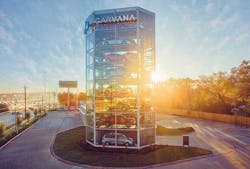Billed as “the world's first fully-automated, coin-operated car vending machine,” Carvana vending machines are starting to “protrude” from high visibility properties around many urban areas lately. Beyond visual interest, this belies a subtle shift we see in the automotive retail typology moving forward. It’s much less about advertising as in the past, and more an all-out assault on the conventional car buying model, which traditional dealerships are being forced to address.
Significant changes are underway as automotive manufacturers and retailers try to anticipate consumer demands in changes in their business models. Traditional Sales, Leasing and Service are now complicated by subscription services like cars2go by Mercedes-Benz, incremental ownership models and the impending autonomous driving car. Outside influences of driver services such as Uber and Lyft also are challenging the notion of car ownership as a basic need. At the core of all these new business models are efforts to bring more convenience to the buyer, making the process virtual while requiring less capital investment and operational cost for businesses attached to the car.
Demand for automotive retail and brand presence has not changed, but the shift back to the urban core after a long period in suburbs, as highways icons and low cost city perimeters, is following the income demographic and tax base. Fundamental problems of this move are highly restrictive zoning regulations, environmental impact, traffic mitigation and infrastructure needs to support the modern dealership model demands. Vertical dealership models are extremely expensive and require years of potential rezoning or conditional use permits and council approvals combined with elevated construction costs employing car elevators and ramps for upper floors to replace acreage used to hold inventory. Most difficult is the scarcity of land and proformas, which justify a site in a city as the highest and best against return on investment.
A Carvana type model seeks to change the process to a fully automated online experience, which reduces operational cost to sell, perform the finance process and service the vehicle, while also decreasing capital expenses of building and developing large buildings. The doorstep delivery model means these vertical dealerships simply house the cars that have already been selected online, om itting the conventional sales and financing process all together. The equation simply becomes an algorithm of how many and what type of cars are stored in which locations based on aggregating search patterns and general income factors. This new model means the inventory is distributed to the nearest & the most likely buyers depending on age, buying patterns and income.
Without fixed operations (car repair and service), the new model allows for more integration into existing zoning in congested areas where traditional dealerships still require administrative constraints. It also removes the associated fixed cost for staff, expensive financing of inventory of parts and space for vehicles. As there is no significant traffic generation, the environmental impact fees are assumed to be generally small. The online interface and support, along with door to door delivery, is a unique experience, and it will be interesting to see how the main manufacturers adopt similar strategies within the strict franchise agreements that rule primary market areas that are designed to restrict heavy overlap of competing dealership owners per brand.
While the Carvana model is currently only targeting the sales of pre-owned vehicles, manufacturers are looking with interest to expand their footprint in new models. The primary question for automotive retailers should be, how do we remain relevant in the process? As designers of compelling branded retail spaces are concerned, the shift seems most likely to move towards the model of brand centers, such as Europe and Asia, which mirror more closely the Tesla showroom model, or most abstracted still, the recently opened Cadillac House in Manhattan. It will be critical how the manufacturers maintain their brand equity without relying on a compelling retail space, or human sales associates as brand messengers.
About the Author
Gensler
A global design firm with more than 5,000 practitioners networked across five continents, Gensler features insights and opinions of architects and designers on how design innovation makes cities more livable, work smarter, and leisure more engaging. Our contributors write about projects of every scale, from refreshing a retailer’s brand to planning a new urban district, all the while explaining how great design can optimize business performance and human potential. For more thought leadership and blog content, visit our Research & Insight page. Follow us on Facebook, LinkedIn, and Twitter.



